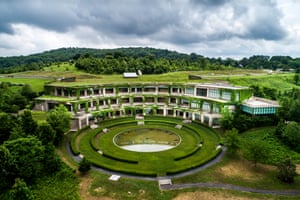How the US has prepared for nuclear Armageddon – in pictures
Since the days of the Truman administration, American officials have planned how to keep the government functioning during a nuclear Armageddon. Though details of the country’s post-doomsday planning are classified, evidence of their decades-long efforts – some abandoned, some active – are hidden in plain sight around Washington DC and beyond
-
Cannonball, Pennsylvania
The remains of a nuclear-hardened microwave tower, known by the codename Cannonball, rises above the Appalachian mountains near Sylvan. Cannonball was one of a network of towers secretly built during the cold war to facilitate communications between the White House and other continuity of government facilities in the event of a nuclear disaster. The 103-ft tower was deactivated in 1977
-
Vivos xPoint, South Dakota
Former munitions bunkers the developer Robert Vicino is repurposing into a doomsday community for civilians. Vivos estimates that its 575 bunkers can hold 5,000 people
-
Mount Weather Emergency Operations Center, Virginia
A passing truck’s lights colour a long exposure image of the top-secret 564-acre facility, which would serve as a relocation site for members of the executive branch, including those from Homeland Security, in the event of a nuclear war. Though no journalists have visited the site, they became aware of its existence in 1974, when a TWA airliner crashed into the mountain, killing all 92 people aboard
-
White Sulphur Springs, West Virginia
A dormitory for lawmakers inside a once-secret cold war nuclear bunker built for members of Congress beneath Greenbrier, a four-star resort near White Sulphur Springs. The 112,544 sq ft (34,303-sq metre) bomb shelter, completed in 1961, included enough beds and supplies to accommodate all 535 lawmakers, as well as one staff member each
-
-
White Sulphur Springs, West Virginia
The press briefing room inside the bunker. There were also decontamination chambers and an intensive care unit, all surrounded by 3-5ft of concrete
-
Raven Rock Mountain Complex, Pennsylvania
The B entrance portal into a 650-acre nuclear bunker and national security site built in a hollowed-out mountain near Blue Ridge Summit. Constructed during the cold war, the facility was conceived as a backup for the Pentagon and built to house military leaders, as well as the president, in the event of a nuclear disaster. Entry is through one of four portals, each protected by a 34-ton blast door
-
Atlas ICBM launch site, Wyoming
A decommissioned coffin-style Atlas E intercontinental ballistic missile launch site near Meriden. The Atlas was the first ICBM developed by the US; 28 Atlas E missiles were operational in 1961-65. The missiles were laid flat in the silos and would be raised to an upright position before launch. The development of ICBMs‚ which drastically reduced the time required for a nuclear strike‚ hastened the development of continuity of government procedures, and helped give rise to the military doctrine of mutually assured destruction
-
Freedman’s Bank, Washington DC
An armoured and unceremonious exit (right) from the White House in the back of the Treasury Annex, now known as Freedman’s Bank. The bank connects to the White House via two tunnels – one under Pennsylvania Avenue to the Treasury Building (left), the second under East Executive Avenue from the Treasury Building to the East Wing of the White House. According to the White House Historical Association, the escape tunnel to the Treasury went out of favour after the construction of the Presidential Emergency Operations Center beneath the White House
-
-
Quebec-01, near Cheyenne, Wyoming
The decommissioned control centre inside Quebec-01, the only Peacekeeper missile launch facility left in the country. The Peacekeeper was the most destructive ICBM in the US arsenal. It could carry 12 nuclear warheads, each with a 300-475 kiloton payload. The missile was conceived as a counterstrike weapon. In the event of a nuclear attack from the USSR, the Peacekeeper promised a devastating response, theoretically ensuring the defensive doctrine of mutually assured destruction
-
Mount Pony, Culpeper, Virginia
The site of a former nuclear bunker known as Mount Pony, where the Federal Reserve secretly stockpiled billions of dollars in cash, which they planned to use to replenish currency supplies after Armageddon. In 2007 the facility was converted to the Library of Congress’s Packard campus for audio-visual conservation. It now provides underground storage for the library’s vast collection of films and audio recordings
-
Corkscrew, Maryland
A nuclear-hardened communications tower and bunker known by the codename Corkscrew, on Lamb’s Knoll near Park Hall. Corkscrew was one of a network of towers secretly built during the cold war. It has since been deactivated and the site is now used by the Federal Aviation Administration
-
Cheyenne Mountain air force station, Colorado Springs
The north entrance portal – part of a two-mile long tunnel blasted through granite – serves as the primary entrance to the North American Aerospace Defense Command facility. More than 300 people work inside Cheyenne Mountain
-
-
Cheyenne Mountain air force station, Colorado Springs
One of two 23-ton blast doors that serve as the primary entrance for the North American Aerospace Defense Command facility. The secret government complex is built 2,000 ft beneath the summit of the mountain, in a bunker that can withstand a 30 megaton nuclear bomb, an electromagnetic pulse, and chemical, biological, and radiological attacks
